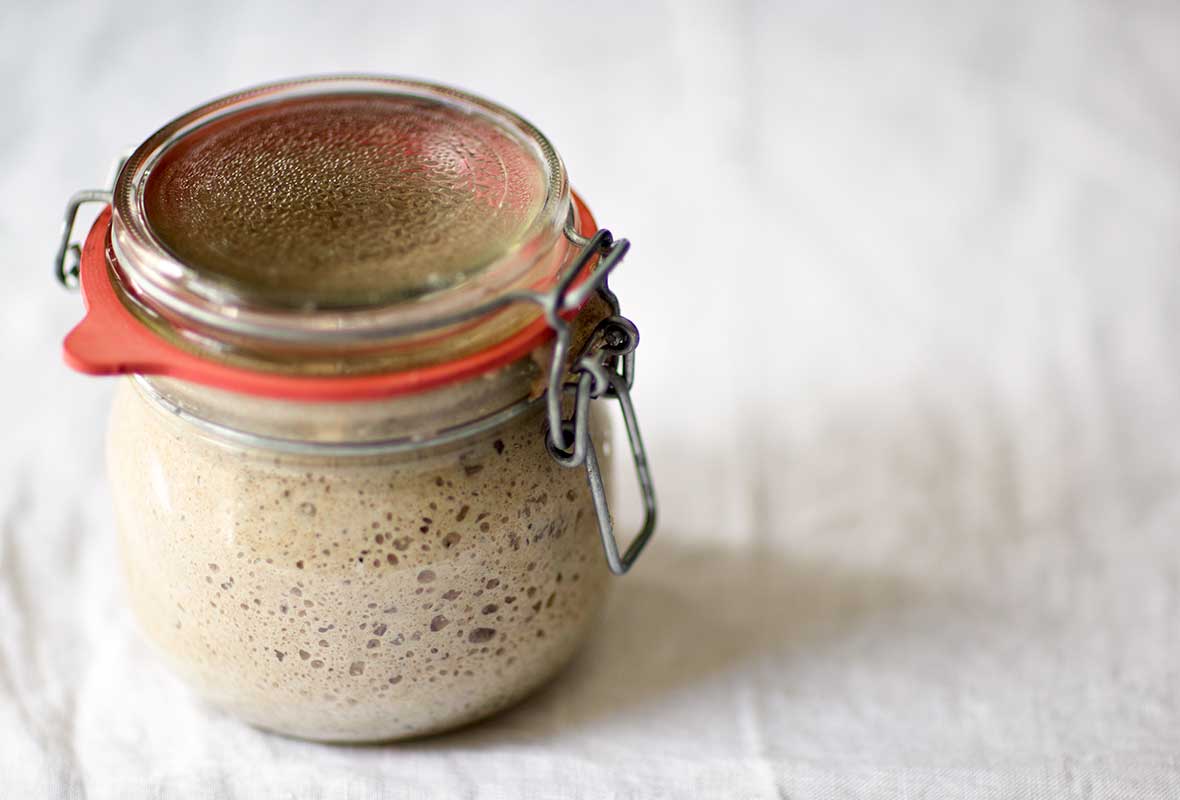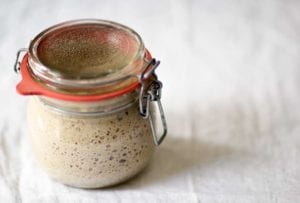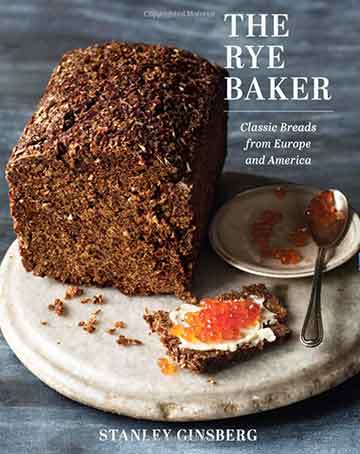
It’s not hard to make a rye sourdough starter from scratch. Some sourdough starters rely on wild yeasts that live in the air, others on acid-producing bacteria present in buttermilk, yogurt, pineapple juice, and the like, and still others start with commercial yeast or store-bought starters. Fact is, none of these additives is necessary. All it really takes to build a delicious and robust rye sour culture, or starter, is some whole-grain rye flour, water, a warm place, and patience. [Editor’s Note: And when your traditional rye sourdough starter is complete, the very first thing you’re going to want to do is use it to make this Galician rye bread.]–Stanley Ginsberg
☞ LEARN MORE, READ: HOW TO DRY SOURDOUGH STARTER

Rye Sourdough Starter
Ingredients
Day 1: Make the Rye Sourdough Starter
- 2.5 ounces whole grain rye flour, preferably organic
- 2.5 ounces warm water (105°F or 41°C)
Days 2 to 7: Refresh the Rye Sourdough Starter
- 2.5 ounces whole grain rye flour, preferably organic
- 2.5 ounces warm water (105°F or 41°C)
- 2.5 ounces Sour Starter from the preceding day
Days 8 and Beyond: Maintain the Rye Sourdough Starter
- 2.5 ounces medium or whole-grain rye flour, preferably organic
- 2.5 ounces warm water (105°F or 41°C)
- .25 ounces rye sourdough starter
Instructions
Day 1: Make the rye sourdough starter
- Start with equal amounts of organic rye flour and water by weight. Dump them in a nonreactive (glass, porcelain, stainless-steel, plastic) container, mix by hand into a stiff paste, cover, and let stand at room temperature (68 to 72°F or 20 to 22°C) for 24 hours.
☞ TESTER TIP: Occasionally the yeast normally present in whole grains fail to establish itself in a new culture; if, after 3 or 4 days, the culture darkens, develops a mold, or smells bad, dump the whole batch and start over. After a week, the culture, or sourdough starter, will be ready to use or to be stored refrigerated in an airtight container for a couple days. [Editor's Note: If storing the sourdough starter for more than a couple days, you'll need to maintain it, which we explain how to do just below.]
Days 2 to 7: Refresh the rye sourdough starter
- The next day, discard all but 2 1/2 ounces (70 grams) of the culture and mix the remainder with the refresh ingredients, cover, and let stand. Repeat each day, discarding all but 2 1/2 ounces (70 grams) of the preceding day’s culture.
☞ TESTER TIP: The most important point to remember at the early stages is to feed the sourdough starter daily. Even when it shows no apparent fermentation, the yeast is busy multiplying and consuming nutrients at a very high rate. By the second or third day, it will swell, show bubbles, and give off a clean sour smell. Over the next few days the activity will become more and more vigorous and the smell more intense.
Days 8 and Beyond: Maintain the rye sourdough starter
- In a perfect world—or in a working bakery—sourdough starters are refreshed daily. That said, daily feedings demand both a degree of dedication and abundant flour supplies that are impractical for all but the most committed home bakers. You can get by refreshing your starter every 36 hours or so.
- Mix the rye flour, water, and rye sourdough starter by hand until incorporated. Cover and ferment at room temperature (68 to 72°F or 20 to 22°C) overnight or for 10 to 12 hours. The sponge will be very bubbly, have a clean sour smell, and will have tripled in volume. Store refrigerated in an airtight container and it will last indefinitely.

Nutrition
Nutrition information is automatically calculated, so should only be used as an approximation.
Recipe Testers’ Reviews
The rye starter was easy to make and quick. It took about 5 minutes each of the 7 days. Mine smelled great and seemed consistent after the week of feedings. I switched to the refresh amounts after that and it stayed nice and healthy.
During the buildup, you end up tossing about 2/3 of it away. I definitely recommend a scale versus just using volume measurements.










I am following this recipe…my starter is on its 4th day…it smells like sour vinegar…not too much action going on with it, just a few bubbles. Should I chuck or wait?
Marnie, I would keep feeding it. What type of flour are you using?
Using organic rye flour.
Marnie, I say press on.
I will give it two more days then its down the toilet…some people name their starter… I am gonna call mine lazy…doesn’t want to work!
Marnie, a few tips. Feed your starter more often, like every 8 hours. (I know, a pain in the ass, but it’s just for now.) Also, make sure the temperature is between 70° and 85°F. I have a proofing feature on my oven, but before I did, I’d turn the oven on low for 30 seconds just to warm it. Then I put the starter in. It usually worked.
hi! thanks for the great recipe. a question: when i bring it out of the fridge to make bread, the advice is to feed it for a couple of days. can you share what are the percentages for those feedings? thanks a lot!
Hui, maru. You’d follow the ratio in the “Day 8 and Beyond” section: 1 part starter to 10 parts water and 10 parts rye flour. So, in the section it’s .25:2.5:2.5–meaning .25 ounce of starter to 2.5 ounces of water and 2.5 ounces flour. Make sense?
makes total sense, thanks for your advice! im very excited about this as i love this type of bread and cannot find it where i now live (pamplona). the quarantine has brought sthing good! stay safe and thanks again.
maru, let me know how it turns out!
Hi David! The starter has turned out fantastic. I´m going crazy making a variety of breads looking for the perfect one, but I don´t think I ever will because they are all perfect in their own way.
Do you have any advice on how to freeze a starter? I´d like to leave a frozen one just in case something happens to the one I´m working with.
Warm regards!
Maru
maru, I love that starter turned out great for you! And freezing it is easy. Just put 1/2 to 1 cup of in a zip-top bag, squeeze the air out, and freeze it. Let it defrost and continue to feed as usual. You can also dry it for really long-term storage.
Hello David,
I’m sorry to jump in on this older question, but I am a little confused. I thought the .25:2.5:2.5 was only to keep it alive but it says here that is enough to get it going to bake? the last time I started feeding it 1:1:1 until bake day to get it up.
Hi, Pat! No need to apologize for jumping in on an older question. It’s always good to revisit things.
The .25:2.5:2.5 is to keep it alive. And if you make the Galician Rye bread this is for, it’s more than enough for that, too, to make the levain.
I asked where you got the 1:1:1 ratio? That’s my personal ratio, is that what you’re referring to?
Yes, like for the equal parts when buildings by the starter?
Patti, that was my personal starter ratio…at the time. Now I’m 1:10:10. (I’m always experimenting.) So I now use 5 grams starter, 50 grams flour, 50 grams water. But I’m not making this loaf; I’m making a different type of bread. I’d stick to the original ratios if you’re making this loaf. Does that make sense?
Hi! Why are there so many different ratios? I often see 1:1:1 or 1:2:2 and you suggest 1:10:10. I have been feeding mine 1:1:1 and am just reading your feed. Confused. Also – how do i when my starter is ready to bake with? Thanks!
Heather, there are different ratios due to several things: baker’s preference, the type of flour, length of time the baker wants the starter to mature, etc. As far as your starter, you want it to rise and fall in a regular pattern and be as strong as possible. My personal starter is also 1:1:1. When I want to bake, I take it out of the fridge two days before and fee it every 8 to 12 hours. It will be at its maximum potential as it reaches its apex.
Hi, David! I just need a bit of clarification. Following Day 7 I have around 7.5 ounces of Sour Starter. According to the recipe, on Day 8 I use 0.25 ounces of the starter. Where the rest of the starter (7.5-0.25=2.25 ounces) goes?
Erin, it would be discarded, as in the previous steps. You can use some of it to make a loaf or two. But to get the starter in fighting condition, you need to keep adding new flour.